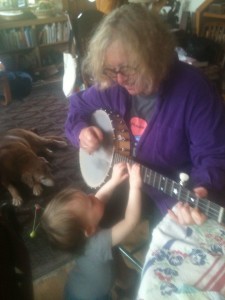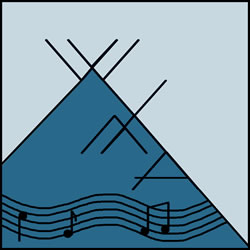 Jeanie Murphy grew up to the music of Jean Ritchie, Pete Seeger, Cisco Houston, and more near Boston, MA. Her father loved odd instruments and had books of folksongs all over the house. He sang her “The Fox Went Out on a Chilly Night.” However, classical music prevailed, and Murphy started playing recorder and piano at five, flute at seven, and singing classically in high school. Then, at college, ran into dulcimers. Murphy says “That was my downfall. I quickly added autoharp and then banjo to my pile of instruments and later, guitar. Much later, thanks to marrying a luthier, I started on fiddle.”
Jeanie Murphy grew up to the music of Jean Ritchie, Pete Seeger, Cisco Houston, and more near Boston, MA. Her father loved odd instruments and had books of folksongs all over the house. He sang her “The Fox Went Out on a Chilly Night.” However, classical music prevailed, and Murphy started playing recorder and piano at five, flute at seven, and singing classically in high school. Then, at college, ran into dulcimers. Murphy says “That was my downfall. I quickly added autoharp and then banjo to my pile of instruments and later, guitar. Much later, thanks to marrying a luthier, I started on fiddle.”
The banjo, however, is Murphy’s home base. She says, “I never get tired of it and love the availability now of so many styles and especially old recordings. I started using the banjo as backup for singing, then moved into playing solos and backing up fiddle. I love all the different tunings, picking styles, and different kinds of banjos, such as minstrel and picolo.”
Murphy has taught at this camp, frequently at The Festival of Fiddle Tunes in Port Townsend, and at various other venues. She mostly plays now with our band: The Possum Carvers (southern tunes) / Glutton-Free Loafers (northern tunes) at dances, farmers’ markets, and other venues. Gigs have taken her everywhere from Estonia to Alaska, but mostly now they congregate on the Olympic Peninsula.
Class: Old-Time Claw Hammer Banjo (Intermediate and Advanced)
Description of skills to be taught:
Everything is taught through old-time tunes and songs. Context is everything. We start with reviewing rock solid right hand rhythm, including drop thumb as needed. Old-time two- and three-finger picking if desired. Left hand techniques with pull-offs, hammer-ons, and slides. Open G, double C, and A modal (“sawmill”) tunings start us off, but then we’ll go to variants such as Reuben, Last Chance, Cumberland Gap and other tunings that take us back to the old days of the fretless banjo. Backing up singing vs. backing up a fiddle. Tips ‘n tricks!
Throughout, context. Where the song comes from, who plays it, how it evolved (all to the best of my knowledge and what we can find that’s reputable on the Interwebs)!
And most of all–we teach each other. We go where the wind blows.
I abominate tablature but recognize some may need it. (I’ve used it myself.) However, I do not usually provide it but rather work with call and response. You need your ears to hear yourself and others. This music doesn’t really tab out easily, let alone submit itself to classical notation! Learning to hear odd scales with microtones, odd rhythms that go back to Africa, that’s the heart and soul of things.
Intermediate and Advanced Old-Time Banjo. However, if you are a beginner, we’ll fold you right in. Don’t you worry! We’ve done it before!
Tentative plan:
Monday: G tunes that gradually get more difficult, with G variant tunings in the afternoon. Work with fiddlers.
Tuesday: Review. Double C tunes that gradually get more difficult, with C variant tunings in the afternoon. Work with fiddlers.
Thursday: Review. A modal tunes that gradually get more difficult. Other cool tunings, maybe some picking. Work with fiddlers.
This plan may change at any moment depending on who is in the class and what they want!
